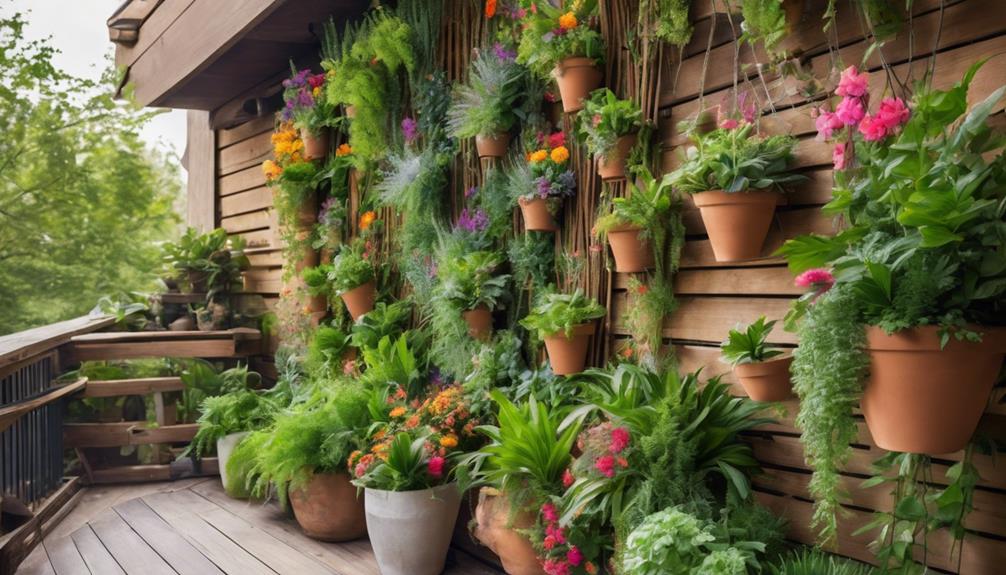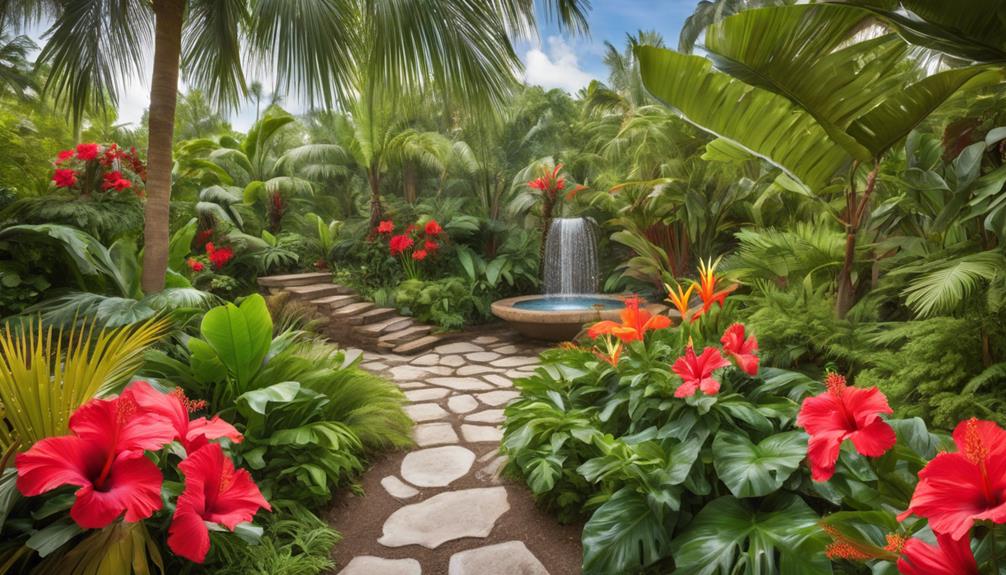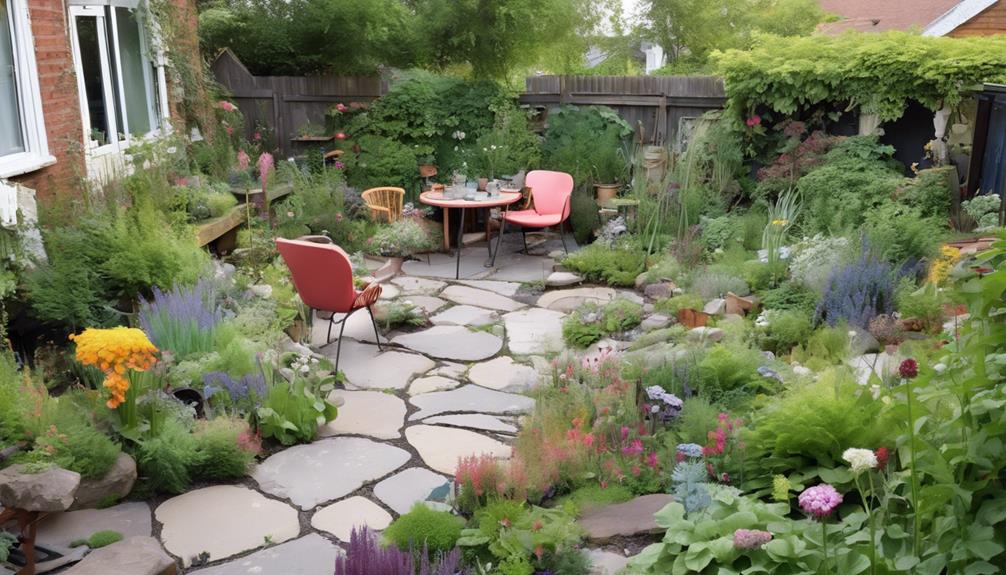
10 Best Water Features for Stunning Garden Design
15 September 2024
7 Tips for Designing Shaded Garden Spaces
16 September 2024Vertical gardens are ideal for maximising greenery in small spaces.
Consider using tiered planters, wall-mounted pots, or hydroponic setups to optimise your area effectively.
Select suitable plants such as herbaceous plants, ferns, and succulents, ensuring they align with varying light and water requirements.
Implementing drip irrigation can achieve consistent moisture while enhancing sustainability.
Additionally, utilising weather-resistant materials for structural support will guarantee durability.
Regular maintenance, including pest control and appropriate fertilisation, keeps your garden thriving.
For a deeper understanding of how to create the perfect vertical garden, continue exploring these creative ideas tailored to small spaces.
Vertical Gardening Benefits Small Spaces
Vertical gardening offers significant advantages for small spaces, primarily through effective space optimisation techniques that make the most of limited areas.
By utilising vertical surfaces, these gardens not only enhance aesthetic appeal but also improve air quality by filtering pollutants and increasing oxygen levels.
As urban environments continue to grow denser, the benefits of vertical gardening become increasingly vital for both functionality and well-being.
Space Optimization Techniques
Maximising limited space is a critical consideration for urban dwellers and homeowners alike, and vertical gardening emerges as a groundbreaking solution.
By utilising vertical surfaces, such as walls and fences, one can transform otherwise underutilised areas into lush, thriving green spaces. This technique not only improves aesthetic appeal but also allows for the cultivation of a diverse array of plants, from herbs to ornamental flora.
Incorporating modular planters and wall-mounted systems facilitates easy access and maintenance, while ensuring ideal light exposure. Furthermore, strategically placing plants based on their growth habits and sunlight requirements can greatly improve yield.
Ultimately, vertical gardening redefines the concept of space, enabling individuals to welcome nature without sacrificing precious square footage.
Improved Air Quality
Enhancing air quality stands out as one of the most notable benefits of incorporating vertical gardens into small spaces.
These innovative green structures effectively filter harmful pollutants, such as volatile organic compounds (VOCs) and carbon dioxide, through the natural processes of photosynthesis and respiration. The diverse plant species utilised in vertical gardens contribute to increased oxygen levels, creating a fresher and healthier indoor environment.
Furthermore, the microorganisms within the soil assist in breaking down toxins, promoting a comprehensive sense of well-being. The strategic placement of vertical gardens can also mitigate temperature fluctuations and humidity levels, thereby enhancing comfort.
Plant Selection and Arrangement
When selecting plants for a vertical garden, it is vital to consider their light requirements to ensure optimal growth and health.
Furthermore, understanding the watering needs and techniques specific to each plant will promote sustainability and reduce maintenance efforts.
Lastly, careful attention to plant spacing and density is fundamental for maximising space while allowing for air circulation and aesthetic appeal.
Light Requirements for Plants
Understanding the light requirements of plants is vital for successful vertical gardening in small spaces. Different plants thrive under varying light conditions; hence, careful selection and arrangement are important.
To enhance growth and health, consider the following factors:
- Light Intensity: Assess the specific light needs of each plant, which can range from low to high light requirements.
- Duration of Light: Ensure that plants receive adequate daily light exposure, typically between 6 to 12 hours, depending on the species.
- Positioning: Position plants strategically, utilising vertical structures to increase light exposure while minimising shade from adjacent plants.
- Supplemental Lighting: In particularly dim spaces, consider using grow lights to provide the necessary light spectrum for optimal growth.
Watering Needs and Techniques
Effective watering techniques are critical for maintaining healthy plants in vertical gardens, especially in small spaces where resources may be limited.
Understanding the unique watering needs of your chosen plants and employing efficient methods can greatly enhance growth and sustainability.
- Drip Irrigation: Utilise a drip irrigation system to deliver water directly to the root zone, minimising evaporation and runoff.
- Self-Watering Containers: Implement self-watering systems that allow for consistent moisture levels and reduce the frequency of manual watering.
- Soil Moisture Sensors: Install sensors to monitor soil moisture, ensuring you water only when necessary and preventing overwatering.
- Watering Schedule: Establish a regular watering schedule, adjusting based on seasonal changes and plant requirements to maintain optimal hydration.
Master these techniques to cultivate a thriving vertical garden.
Plant Spacing and Density
In vertical gardens, plant spacing and density play a crucial role in determining the overall health and productivity of the garden. Proper spacing ensures that plants receive adequate light, air circulation, and nutrients, thereby minimising competition and promoting growth.
Consider the following guidelines for ideal plant arrangement:
- Plant Height: Taller plants should be positioned at the top to prevent shading smaller species below.
- Growth Habit: Group plants with similar growth habits to maintain uniformity and ease of maintenance.
- Root Space: Ensure adequate root room by selecting plants with compatible root structures to avoid overcrowding.
- Seasonal Rotation: Implement a rotating system to allow for seasonal variations and prevent soil depletion.
Adhering to these principles will enhance the health of your vertical garden.
Vertical Garden Setup Guide
Establishing a successful vertical garden requires careful planning and execution.
Key considerations include selecting the ideal location that provides adequate sunlight and accessibility, utilising quality soil mixtures to promote healthy plant growth, and exploring hydroponic systems for efficient water and nutrient delivery.
Choose the Right Location
Choosing the perfect location for your vertical garden is vital to its success and overall health. A well-selected site will ensure optimal growth conditions and visual appeal.
Consider the following factors when determining the best placement:
- Sunlight Exposure: Evaluate the amount of direct sunlight the area receives, as most plants require a minimum of six hours of sunlight each day.
- Accessibility: Ensure the garden is easily reachable for maintenance, watering, and harvesting.
- Shelter from Wind: Opt for a location that offers some protection from strong winds, which can damage delicate plants.
- Water Drainage: Select an area with good drainage to prevent waterlogging, which can result in root rot.
Use Quality Soil Mixtures
After identifying the ideal location for your vertical garden, the next step involves selecting the right soil mixture to support healthy plant growth.
Quality soil is essential, as it impacts drainage, aeration, and nutrient availability.
Consider the following components when crafting your soil mixture:
- Organic Matter: Incorporate compost to improve nutrient content and enhance soil structure.
- Coconut Coir or Peat Moss: Utilise these materials for moisture retention while ensuring proper aeration.
- Perlite or Vermiculite: Add these to facilitate drainage and prevent soil compaction.
- Slow-Release Fertiliser: Incorporate a balanced, slow-release fertiliser to sustain plant health over time.
Hydroponic Systems for Vertical Gardens
Hydroponic systems offer a groundbreaking approach to cultivating plants in vertical gardens, maximising space and efficiency.
These systems eliminate the need for traditional soil, utilising nutrient-rich water solutions instead, making them ideal for urban environments.
To successfully implement a hydroponic vertical garden, consider the following crucial components:
- Growing Medium: Opt for materials such as coconut coir or rock wool to support plant roots.
- Nutrient Solution: Use a balanced, water-soluble fertiliser to guarantee peak plant growth.
- Lighting: Incorporate LED grow lights to provide adequate light for photosynthesis, especially in indoor settings.
- Water Circulation: Implement a pump system to maintain consistent nutrient flow and oxygenation.
Space-Efficient Plant Growth
Optimising vertical space is essential for achieving space-efficient plant growth in small areas. By utilising vertical gardening techniques, one can enhance the limited area available, allowing for a greater diversity of plants. Implementing tiered planters, wall-mounted pots, or vertical trellises can significantly boost yield while maintaining aesthetic appeal.
| Plant Type | Growth Habit |
|---|---|
| Leafy Greens | Compact and bushy |
| Herbs | Upright and dense |
| Climbing Vines | Vertical growth |
| Succulents | Low profile, spread out |
Careful selection of plant varieties that thrive in vertical systems can further optimise space and light exposure. This approach not only improves plant health but also promotes efficient use of available resources.
Vertical Garden Maintenance Services
Maintaining a vertical garden requires a thorough approach that encompasses effective pest control strategies, precise fertiliser application techniques, and the use of organic fertilisers.
These maintenance services not only promote healthy plant growth but also guarantee the longevity and sustainability of your vertical garden.
Understanding these elements is crucial for achieving a thriving green space in compact areas.
Pest Control Strategies
Effective pest control strategies are essential for the health and longevity of vertical gardens, particularly in small spaces where plant competition can be fierce.
Implementing proactive measures can mitigate the risk of infestations and ensure thriving plants.
- Regular Monitoring: Conduct frequent inspections to identify early signs of pests, such as discoloured leaves or webbing.
- Companion Planting: Strategically intersperse pest-repelling plants like marigolds or basil to deter harmful insects naturally.
- Organic Pesticides: Utilise natural solutions, such as neem oil or insecticidal soap, to minimise chemical exposure while targeting specific pests.
- Cultural Practices: Confirm proper watering and pruning techniques to improve air circulation and reduce the likelihood of pest proliferation.
These methods enhance the resilience of vertical gardens while fostering a sustainable growing environment.
Fertilizer Application Techniques
The health of vertical gardens greatly depends on the strategic application of fertilisers, which provide essential nutrients for optimal plant growth.
Mastery of fertiliser techniques ensures that plants thrive in limited spaces. Here are four fundamental application techniques to consider:
- Foliar Feeding: Apply liquid fertilisers directly to leaves for rapid nutrient absorption, particularly during the growing season.
- Slow-Release Granules: Incorporate slow-release fertilisers into the soil mix to provide a steady supply of nutrients over time, minimising leaching.
- Liquid Fertiliser Dilution: Dilute liquid fertilisers to prevent root burn; apply every 2-4 weeks during peak growth.
- Fertiliser Scheduling: Establish a schedule based on plant growth stages, adjusting frequency and concentration as necessary for optimal performance.
Implementing these techniques will greatly enhance the health of your vertical garden.
Organic Fertilizer Techniques
Incorporating organic fertilisers into vertical garden maintenance improves soil health and promotes sustainable plant growth.
Utilising organic methods not only nourishes plants but also enriches the ecosystem.
Here are four crucial organic fertiliser techniques to enhance your vertical garden:
- Compost Tea: Brew nutrient-rich compost in water and apply it as a liquid fertiliser to increase microbial activity.
- Worm Castings: Integrate worm castings into your soil mix for a slow-release source of essential nutrients.
- Fish Emulsion: Use diluted fish emulsion for immediate nutrient uptake, especially during the growing season.
- Bone Meal: Incorporate bone meal into the soil for an increase in calcium and phosphorus, which are important for root development.
Adopting these techniques guarantees a thriving vertical garden, maximising both yield and sustainability.
Inefficient Water Drainage Issues
Inefficient water drainage can considerably hinder the health of vertical gardens, leading to waterlogging and plant stress.
To address this issue, adjusting the drainage angle, incorporating gravel for improved permeability, and optimising the overall water flow design are crucial strategies.
Implementing these solutions ensures that excess water is effectively managed, promoting a thriving vertical garden even in limited spaces.
Adjust Drainage Angle
Proper drainage is essential for the success of any vertical garden, particularly in small spaces where water accumulation can lead to root rot and other issues.
Adjusting the drainage angle is crucial in ensuring that excess water flows away from the roots, thereby promoting healthier plant growth.
Consider the following strategies to optimise drainage:
- Elevate the Base: Raise the bottom of your vertical garden slightly to create a slope for water runoff.
- Incorporate Drainage Holes: Ensure that each planting compartment has adequate drainage holes.
- Use Lightweight Materials: Select containers that are designed to facilitate drainage without adding unnecessary weight.
- Regular Maintenance: Periodically inspect and adjust the angle as needed to prevent blockages and ensure effective drainage.
Implementing these adjustments can significantly improve the health of your vertical garden.
Improve Drainage With Gravel
To enhance drainage in vertical gardens, the incorporation of gravel can be an effective solution for tackling inadequate water drainage issues.
Gravel acts as a natural filter, preventing soil compaction and allowing excess water to flow freely. Here are some key considerations for integrating gravel effectively:
- Layering: Position a layer of gravel at the bottom of the planting structure to facilitate drainage and mitigate waterlogging.
- Particle Size: Select gravel with varying particle sizes to improve aeration and water movement.
- Maintenance: Regularly inspect and refresh the gravel layer to ensure optimal drainage performance.
- Integration with Soil: Blend gravel with potting soil to enhance drainage properties while providing essential nutrients for plant growth.
Implementing these strategies can significantly improve the drainage efficiency of your vertical garden.
Optimize Water Flow Design
Effective water flow design is crucial in addressing drainage challenges within vertical gardens.
By optimising water management, you can prevent plant disease and ensure that each level receives adequate moisture.
Here are four key strategies to consider:
- Incorporate a drip irrigation system: This method allows for precise water delivery, minimising runoff and ensuring thorough moisture penetration.
- Utilise sloped planting beds: Designing sloped surfaces encourages water to flow downwards, reducing pooling and enhancing drainage efficiency.
- Select breathable materials: Choose pots or containers with drainage holes and breathable fabrics to facilitate proper air circulation and prevent waterlogging.
- Implement a water catchment system: Collect excess runoff for recycling, promoting sustainability and maintaining soil hydration.
Why Choose TKL Birmingham Gardener
Choosing TKL Birmingham Gardener for your vertical garden project offers a blend of expertise and personalised service that sets them apart in the industry.
Their team of experienced horticulturists possesses in-depth knowledge of plant selection and vertical gardening techniques, ensuring that your project thrives.
TKL Birmingham Gardener employs cutting-edge design strategies tailored to your specific space, maximising aesthetic appeal and functionality.
With a commitment to sustainability, they utilise eco-friendly materials and methods that enhance the health of your garden and the environment.
Their hands-on approach fosters collaboration, allowing you to actively participate in the design process.
Common Vertical Garden Questions
Vertical gardens have gained popularity as a practical solution for maximising limited space while enhancing aesthetic appeal. Many prospective gardeners often inquire about the best plants for vertical systems. Typically, herbaceous plants, ferns, and succulents thrive in these setups due to their adaptable nature and low maintenance requirements.
Another common question relates to irrigation; drip irrigation systems or self-watering mechanisms are highly recommended to ensure consistent moisture without over-saturation.
Furthermore, the structural integrity of the chosen framework is vital—materials should be durable and weather-resistant to withstand environmental conditions.
Final Thoughts on Vertical Gardening
Creating a vertical garden can be a rewarding endeavour that not only beautifies your space but also enhances your connection to nature.
By employing thoughtful design and planning, you can transform even the smallest areas into lush, vibrant displays.
To achieve mastery in vertical gardening, consider the following:
- Plant Selection: Choose plants that thrive in vertical arrangements, such as trailing vines or compact herbs.
- Structural Support: Invest in durable frameworks that can withstand varying weather conditions and provide adequate support.
- Watering System: Implement an efficient irrigation system to ensure consistent moisture without over-saturating plants.
- Light Exposure: Assess sunlight availability and position your garden to optimise light for ideal growth.
Embrace these principles to cultivate a thriving vertical garden that reflects your personal style.




